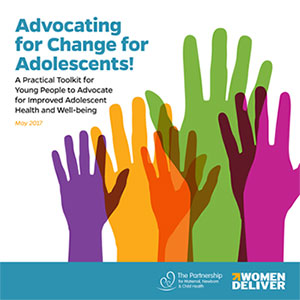This toolkit was developed through a collaborative effort led by Women Deliver and The Partnership for Maternal, Newborn & Child Health (The Partnership) and supported by consultations with members of The Partnership’s Adolescent and Youth Constituency at country, regional and global levels, as well as technical partners and allies working on adolescent health and wellbeing.
 Adolescents are a diverse group of people, all experiencing numerous life changes—physical, mental, and social—that will affect their health and wellbeing for the rest of their lives. For this reason, strategic investments in adolescents’ health and wellbeing are critical interventions that can have a major impact. Such investments can: have economic and social benefits amounting to 10 times more than they cost, save 12.5 million lives, prevent more than 30 million unwanted pregnancies, and prevent widespread disability. Yet, despite compelling evidence of these benefits, adolescent health and wellbeing remains neglected in most countries, and, as a result, adolescence remains a life period when many face great risks.
Adolescents are a diverse group of people, all experiencing numerous life changes—physical, mental, and social—that will affect their health and wellbeing for the rest of their lives. For this reason, strategic investments in adolescents’ health and wellbeing are critical interventions that can have a major impact. Such investments can: have economic and social benefits amounting to 10 times more than they cost, save 12.5 million lives, prevent more than 30 million unwanted pregnancies, and prevent widespread disability. Yet, despite compelling evidence of these benefits, adolescent health and wellbeing remains neglected in most countries, and, as a result, adolescence remains a life period when many face great risks.
“Adolescents and young people aren’t just the future leaders of the world, they are the leaders of today,” said Tamara Windau-Melmer, Senior Manager of Youth Program and Advocacy for Women Deliver. “Young people have called for more tools to support their advocacy efforts – and we are listening. This toolkit serves as resource for adolescents and young people to organize their thoughts so they can lead in making positive change in their communities and countries."
Developed by young people, for young people, this toolkit provides guidance to youth networks on the design, implementation, and monitoring of an effective national advocacy action roadmap on adolescent health and wellbeing. It aims to encourage meaningful engagement of youth and drive positive advocacy and accountability efforts to influence national health plans and policy processes. Although it is designed with a youthful audience in mind, others who may be interested in using this toolkit include civil society groups, government departments, and anyone passionate about adolescent health and wellbeing and meaningful partnerships with key stakeholders including young people.


